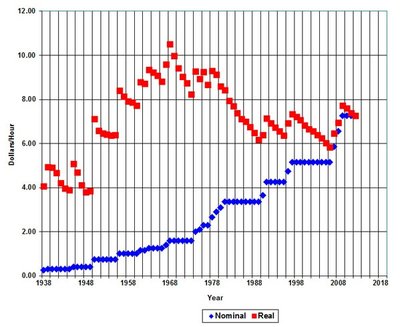Fast-food workers across the U.S. are striking as part of a larger campaign to demand higher wages for hourly jobs.
 Employees at popular food chains in 50 cities, including McDonalds, Wendy’s and Burger King, are expected to be joined by workers at stores owned by retail giants Macy’s, Sears and Dollar Tree.
The strike follows a similar protest last November, when some 200 workers walked off their fast-food jobs in New York City.
The strikers are demanding that the federal minimum wage, the number that the government has decided is the lowest hourly wage allowed, be raise from $7.25 an hour to $15 an hour. The change would more than double annual earnings to about $31,000 a year for a full-time employee. Many fast food workers are paid minimum wage, and many more are not employed full-time (40 hours a week).
While the president and some in Congress are calling for a minimum wage hike, their proposals would seek a smaller increase to $9 an hour.
The strikers are also seeking the right to form unions and negotiate directly with their employers for higher wages.
In
a report from the Associated Press,
20-year-old Shaniqua Davis describes what it is like living on minimum wage and trying to raise her 1-year-old daughter. Davis has a job at the nearby McDonalds making $7.25 an hour. “Her schedule varies, but she never gets close to 40 hours a week. ‘Forty? Never. They refuse to let you get to that (many) hours.’ [Davis said] Her weekly paycheck is $150 or much lower.”
Employees at popular food chains in 50 cities, including McDonalds, Wendy’s and Burger King, are expected to be joined by workers at stores owned by retail giants Macy’s, Sears and Dollar Tree.
The strike follows a similar protest last November, when some 200 workers walked off their fast-food jobs in New York City.
The strikers are demanding that the federal minimum wage, the number that the government has decided is the lowest hourly wage allowed, be raise from $7.25 an hour to $15 an hour. The change would more than double annual earnings to about $31,000 a year for a full-time employee. Many fast food workers are paid minimum wage, and many more are not employed full-time (40 hours a week).
While the president and some in Congress are calling for a minimum wage hike, their proposals would seek a smaller increase to $9 an hour.
The strikers are also seeking the right to form unions and negotiate directly with their employers for higher wages.
In
a report from the Associated Press,
20-year-old Shaniqua Davis describes what it is like living on minimum wage and trying to raise her 1-year-old daughter. Davis has a job at the nearby McDonalds making $7.25 an hour. “Her schedule varies, but she never gets close to 40 hours a week. ‘Forty? Never. They refuse to let you get to that (many) hours.’ [Davis said] Her weekly paycheck is $150 or much lower.”
 In part as a result of demands from the civil rights movement, minimum wage in the late 1960s was the equivalent of about $10 per hour, but fell dramatically through the eighties. The last hike to federal minimum wage was in 2009, though some states have instituted higher minimum wages on their own. Washington state has the highest, at $9.19 an hour.
In part as a result of demands from the civil rights movement, minimum wage in the late 1960s was the equivalent of about $10 per hour, but fell dramatically through the eighties. The last hike to federal minimum wage was in 2009, though some states have instituted higher minimum wages on their own. Washington state has the highest, at $9.19 an hour.

Minimum wage fails to keep up with inflation
The so-called “living wage” movement seeks to require employers to pay workers enough so that a person with a family can afford decent housing, food and transportation. The minimum wage has failed to keep pace with inflation and higher living costs over the years, meaning that minimum wage workers are now having to do more with less. “The minimum wage is now about more than 40 percent below the federal poverty line,” writes Paul Solman, financial news reporter for the PBS NewsHour. “The numbers remind me of the old line in poker: Read 'em and weep.” Below, you can see a chart from Oregon State University of the history of the federal minimum wage, where the blue dots represent the dollar amount of the day, and the red dots represent what that number means in today’s dollars.



